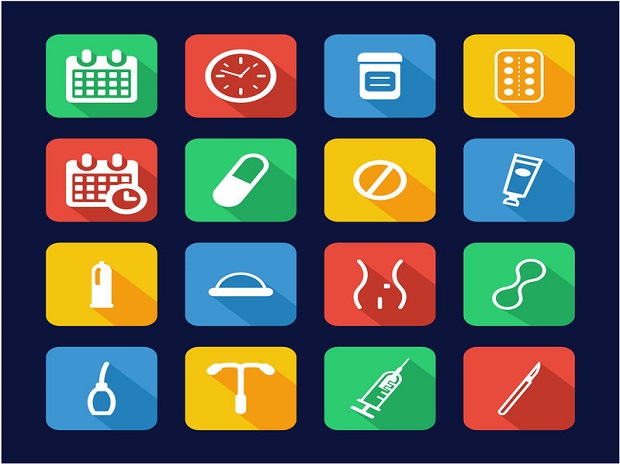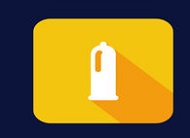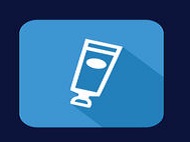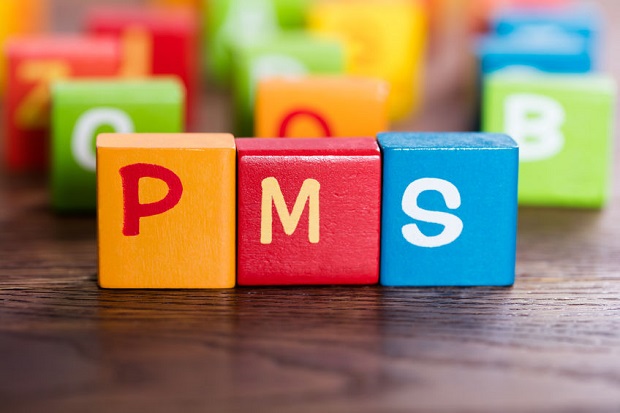
There are several categories of birth control, but the two that carry possible side effects are hormonal birth control methods and barrier birth control methods. Here we will explore the temporary methods that preserve sterility and don’t include natural methods such as withdrawal or fertility awareness, which have no side effects except a higher incidence of an unplanned pregnancy. This article will explore only the side effects of the individual birth control method and not the benefits or effective rates.
Jump Ahead
- Birth Control Pill
- Birth Control Implant
- IUD
- Birth Control Shot
- Birth Control Vaginal Ring
- Birth Control Patch
- Internal Condom
- Diaphragm
- Cervical Cap
- Birth Control Sponge
- Spermicide
- Resources
Hormonal Birth Control Methods
These contain hormones that work as a birth control method by preventing the body from ovulating. It also thickens the cervix’s mucus, making it inhospitable for sperm to pass through. There can’t be a pregnancy when there is no egg and no sperm to fertilize the egg. Many of the side effects are similar when hormones are involved. When considering the side effects of any medication, it’s important to remember that every woman is different.

Birth Control Pill
Birth control pills are taken daily and contain either estrogen and progestin or progestin-only. Side effects can include headaches, mood changes, sore breasts, nausea, and irregular periods are a few of the more common side effects that some encounter. Spotting between periods is another side effect, especially for progestin-only pills. Most side effects associated with birth control pills go away after two or three months. More serious side effects are rare and are associated with the pills that contain estrogen. These can include heart attack, blood clots, stroke, and liver tumors. You shouldn’t take these pills if you smoke or are over 35. [1]

Birth Control Implant
Also known as contraceptive implants, this tiny plastic rod is inserted into the skin of the upper arm. Implants are good for three years and release the hormone etonogestrel. Side Effects can include irregular menstrual periods, mood changes, weight gain, acne, abdominal pain or nausea, breast pain, back pain, headaches, vaginitis, dizziness, and ovarian cysts.
You may also experience side effects from the implantation procedure, including bruising, redness, pain, scarring, and infection. [2]

IUD
There are currently two types of IUDs that work differently. One releases the hormone progestin, while the other is copper, creating a hostile environment for sperm.
Possible side effects of IUDs that release hormones may include headache, acne, sore breasts, irregular bleeding, mood changes, and cramping or pelvic pain. [3]
The copper IUD doesn’t really belong in the group with the hormonal birth control methods. Possible side effects of the copper IUD may include heavy bleeding, which can lead to anemia, pain during sex, backache, menstrual cramps, vaginal infections, vaginal discharge, allergic reactions, faintness, or pain. [4]
You may also experience side effects from the implantation procedure, including pain, cramping, and irregular bleeding. Complications are not common but can be serious. About 1% of women will get pelvic inflammatory disease (PID) within the first 20 days and .5% within the first three to six months after insertion. [5]

Birth Control Shot
The birth control shot is an injection of progestin. The side effects are similar to the other hormonal birth control methods, including headaches, mood changes, sore breasts, nausea, weight gain, and irregular periods. [6]

Birth Control Vaginal Ring
The vaginal ring releases the hormones estrogen and progestin and will likely have the same side effects as birth control pills containing the same hormones, which may include headaches, mood changes, sore breasts, nausea, and irregular periods. [7]

Birth Control Patch
Like birth control pills and the vaginal ring, the birth control patch also releases the hormones estrogen and progestin, but research has indicated that the patch may increase estrogen levels more than birth control pills, so it may put you at a higher risk for those complications that involve blood clots. The side effects are similar to taking birth control pills. [8]
Barrier Birth Control Methods
These methods work by creating a barrier that stops the sperm from entering the cervix to fertilize the egg. The birth control sponge contains spermicide, a chemical that slows down sperm mobility. These side effects assume that the product has been used correctly. (For example, leaving in a diaphragm too long has its own list of complications)

Internal Condom
Unlike male condoms, which are primarily latex-based, female condoms are made from polyurethane or nitrile. The only side effect of an internal condom would occur if you have an allergy to either polyurethane or nitrile. [9]

Diaphragm
The diaphragm requires the use of spermicide, so the side effects of spermicide are relevant here. The diaphragm is made of latex or silicone, so those allergic to latex or silicone may have allergic side effects. [10]

Cervical Cap
The cervical cap requires spermicide use, so the side effects of spermicide are relevant here. The cervical cap is made from silicone, so those with a silicone allergy may experience side effects. [11]

Birth Control Sponge
The birth control sponge, also called a contraceptive sponge, is made of polyurethane foam and contains spermicide, so the side effects of spermicide are relevant here. [12]

Spermicide
Nonoxynol-9, an ingredient in spermicide, has been known to irritate the skin and soft tissues. For some, using spermicide can be painful to either one or both individuals engaging in sexual activity. Irritation of the vaginal lining also puts you at increased risk for STDs. You may also be more susceptible to urinary tract infections. [13]
Resources
- [1] Planned Parenthood – “How Safe Is the Birth Control Pill?“
- [2] WebMD – “Birth Control Implants (Contraceptive Implants).“
- [3] Mayo Clinic – “Mirena – Hormonal IUD.”
- [4] Paragard® Intrauterine Copper Contraceptive. – “Paragard® Safety Information.”
- [5] Cleveland Clinic – “Do the Benefits of an IUD Outweigh the Potential Side Effects?“
- [6] US Department of Health and Human Services – “Birth Control Shot.”
- [7] Planned Parenthood – “Birth Control Ring.”
- [8] Mayo Clinic – “Birth Control Patch.”
- [9] Medline Plus. US National Library of Medicine – “Female Condoms.”
- [10] Familydoctor.org – “Birth Control: How to Use Your Diaphragm.”
- [11] Kidshealth.org – “About the Cervical Cap.”
- [12] Mayo Clinic – “Contraceptive Sponge.”
- [13] Mayo Clinic – “Spermicide.”
DISCLAIMER: THIS WEBSITE DOES NOT PROVIDE MEDICAL ADVICE
The information, including but not limited to text, graphics, images, and other material on this website, is for informational purposes only. No material on this site is intended to be a substitute for professional medical advice, diagnosis, or treatment. Always seek the advice of your physician or other qualified healthcare providers with any questions you may have regarding a medical condition or treatment before undertaking a new healthcare regimen, and never disregard professional medical advice or delay in seeking it because of something you have read on this or any other website.





